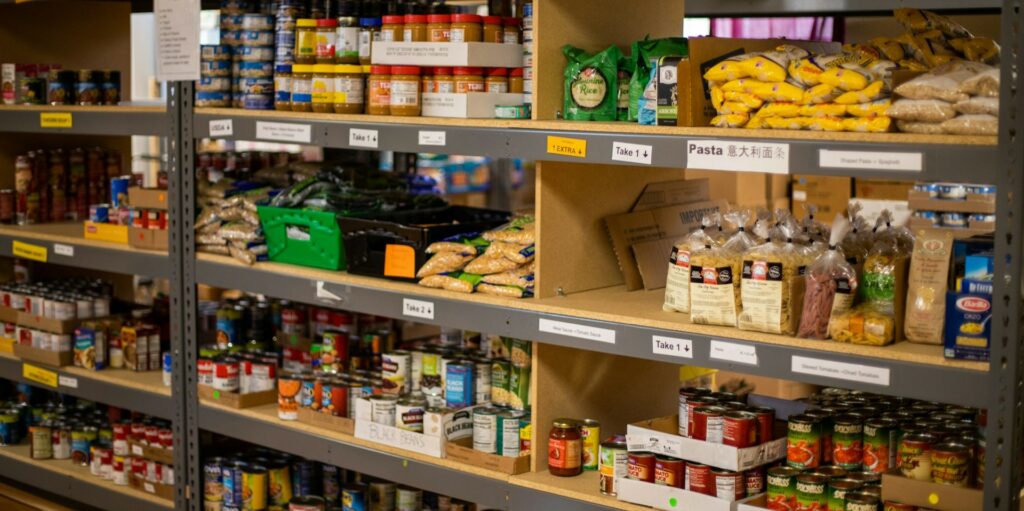
The problem
The numbers of people experiencing food insecurity in the UK have been rising steadily. In turn, food banks have faced rising demand. Whilst originally envisioned as a stop-gap form of relief for people facing emergency financial crises, food banks now often serve people who face chronic financial shortfalls and food insecurity.
Food banks are struggling to meet demand, yet there are also concerns that the help food banks offer is not an empowering or effective solution for reducing food insecurity in the long term.
There is growing interest in helping people move away from food bank support to models that enable people to acquire food through low-cost membership fees. Little, however, is known about the individual-level impacts of accessing such models and the economic sustainability of operation. These models are variously termed social supermarkets, food pantries or affordable food clubs.
The intervention
At the point that a referral to a food bank usually occurs or someone comes to collect a food parcel, an individual’s or household’s situation is assessed to ascertain whether longer-term support from a food pantry may be a better choice for their situation.
Where deemed appropriate, membership into a food pantry model is provided, requiring people to pay a fixed, low-cost usage fee.
Food bank food parcels typically contain about three days’ worth of food, limited fruit and vegetables and are intended for emergency food shortages. In contrast, the food pantry provides a shop-like environment, enabling people to choose a quantity of items for the usage fee each week. Fresh fruit and vegetables are provided alongside refrigerated and frozen produce and basic pantry items.
The research
Primary research question
Does triaging people who are experiencing food insecurity to either receive food parcels from a food bank or membership in a food pantry model lead to better outcomes in terms of food insecurity, dietary quality and wellbeing compared to support from a food bank alone?
Theory of change
Evaluation design
The evaluation will be co-designed with stakeholders. We are proposing a cluster non-randomised controlled trial: two food banks that operate a food pantry compared with two or more food banks that do not operate food pantries.
This will be a pilot trial to assess trial procedure. Insight will also be provided by parallel work being conducted as part of the SALIENT Consortium.
As part of a process evaluation, we will also seek to assess fidelity, acceptability and feasibility for people normally referred to food banks, as well as understanding on unintended consequences and wider impacts. We will assess costs associated with operating a food bank versus a food pantry, and potential differences in food sourcing.
We will conduct economic evaluation and model the potential wider impacts of dietary changes and environmental impacts.
Data collection
To be confirmed pending co-design decisions. We propose repeated questionnaires at baseline and after agreed periods of follow-up. We will include measures of food insecurity, financial insecurity, mental health and well-being and short-form food frequency questionnaire.
Outputs and impacts
We will produce publications reporting the main trial results and modelled impacts on health and environment, process and economic evaluations. We will input into a paper on contributions to system change in community food system.
We anticipate that these findings will be of great interest to other local authorities funding, or looking to fund, similar models and will seek to share our learning nationwide.
Research team
- Dr Rachel Loopstra | Public Health, Policy & Systems, University of Liverpool
- Dr Alexia Sawyer | MRC Epidemiology Unit, University of Cambridge
- Dr Amy Yau | London School of Hygiene and Tropical Medicine
- Dr Jean Adams | MRC Epidemiology Unit, University of Cambridge
- Prof Martin White | MRC Epidemiology Unit, University of Cambridge
- Dr Roxanne Armstrong-Moore, MRC Epidemiology Unit, University of Cambridge
- Prof Emma Frew | Institute of Applied Health Research, University of Birmingham
- Dr Kehinde Adeosun | Institute of Population Health – University of Liverpool
